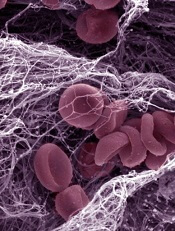
Image by Kevin MacKenzie
Researchers say they have developed a thrombolytic material that can be condensed on a blood clot by means of a magnetic field.
Experiments suggest the material can dissolve clots up to 4000 times more efficiently than thrombolytic agents currently in use.
Vladimir Vinogradov, PhD, of ITMO University in St Petersburg, Russia, and his colleagues described the material in Scientific Reports.
“We prepared a thrombolytic colloid and tested its effects on an artificial blood clot obtained from plasma and blood of humans and thrombus extracted from patients,” Dr Vinogradov said.
“The results may soon allow us to try out the new thrombolytic system on mammals. Now, we are preparing for preclinical studies.”
Specifically, Dr Vinogradov and his colleagues produced a composite material that can deliver thrombolytic enzymes in a targeted manner. The material is composed of a porous magnetite framework and molecules of urokinase, an enzyme frequently used as a thrombolytic agent.
The composite can be used to create thrombolytic coating for artificial blood vessels and stable injectable solutions made of nanoparticles that can be localized near the clot by means of an external magnetic field.
The magnetite framework also protects enzymes from various inhibitors that are present in the blood and can deactivate thrombolytic medications.
“Usually, in order to achieve a prolonged effect for such drugs, the enzyme is placed inside a polymeric matrix,” said study author Andrey Drozdov, of ITMO University.
“The enzyme is then gradually released from the matrix and eventually loses all activity. We, on the other hand, experimentally demonstrated that enzymes protected using our approach do not lose therapeutic properties over extended periods of time and even after repeated use. The rate at which the new drug can dissolve the clot outperforms unprotected enzymes by about 4000 times.”
The researchers also believe the material is safe for humans because it is made of components that are already approved for intravenous injection.


